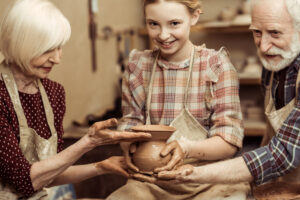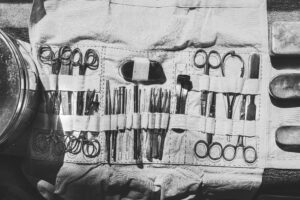The 1800s, a time of huge societal changes and events that changed everything, are an interesting look into a world on the verge of becoming modern. These years, from 1800 to 1899, saw the end of the Enlightenment and the start of the Industrial Revolution. Both had a huge impact on everyday life. At that time, people who lived on farms started to give way to people who worked in factories. This changed economies, social structures, and even the physical landscape of countries. The century covered a wide range of experiences, from the simple lives of farmers in the early 1800s to the complicated, busy lives of people living in cities by the end of the century.
During this time, scientific discoveries and technological advances happened at a speed that had never been seen before. These changes had a huge impact on transportation, communication, and industry. When steam engines, trains, and telegraphs were invented, they linked faraway places together. This led to economic growth and cultural exchange. But these changes brought both good things and problems. As towns got bigger and more jobs opened up, issues like forced labour, overcrowding, and public health crises started to show up.
The 1800s saw a lot of changes in society as well. During this century, there were major efforts for political and social change. These included the fight for women’s rights, democracy, and the end of slavery. People often fought back against these movements, which led to arguments and fights that would shape the future of countries.
The 19th century was a time of a lot of artistic and intellectual work. Romanticism and later Realism in art and writing showed how complicated life is, while improvements in education and literacy made it easier for more people to learn.
In the 1800s, daily life was very different based on where you lived, your social class, and your job. In rural areas, people stuck to their old ways of doing things. At the same time, in cities, new ideas and different cultures came together. Even though there were problems, people’s strength and ability to change in this century made the modern world possible.
We learn about the complexities of life in the 19th century and find a tapestry made of threads of custom and innovation, struggle and progress, that paint a vivid picture of a world in change. The goal of this piece is to look at these aspects and give a full picture of what life was really like in the 1800s.
Daily life in the 1800s
Typical Day in an Urban Setting
In the 1800s, most people who lived in busy towns started their day early. People who worked, especially those who worked in plants, began their days at dawn. People had to work in these industries for long hours, usually from sunrise to sunset, because they were often overcrowded and didn’t have enough airflow. The speed, noise, and smog of city life were very different from life in the country. People on foot, horse-drawn carriages, and street sellers all filled the streets.
In cities, housing was very different. The rich lived in large townhouses or castles, while the poor often lived in tenements that were dirty and crowded. Even with these problems, cities were places where people could find work, go to school, and improve their lives. People in cities often get together with others in public areas, parks, or at cultural events like plays.
Rural Life and Agricultural Work
In the 1800s, farming was still a big part of life in the country. Every day for a farmer and their family started before dawn with work being split up among the family. Men were usually in charge of ploughing, planting, and harvesting food in the fields, while women ran the homes, cared for gardens, and cared for animals.

The seasons and hard work set the rules for life on the farm. Planting and reaping kept them very busy in the spring and summer. Winter gave them a break, but they still had to get ready for the cold months ahead. People in rural areas were very close to each other, and neighbours often helped each other out when farming was busy. Community ties had to be kept strong through social events like barn raisings, church events, and local fairs.
Family Roles and Gender Expectations
Family life in the 1800s was characterized by clearly defined roles based on gender. Men were typically the breadwinners, responsible for providing for the family through work outside the home. In rural areas, this meant farming, while in urban settings, men worked in factories, businesses, or trades.
Women’s roles were primarily domestic. They managed the household, cooked, cleaned, and cared for children. In addition to these responsibilities, women in rural areas often contributed to agricultural work and home-based crafts like sewing or weaving to supplement the family income. Despite their significant contributions, women had limited legal rights and were largely excluded from political and economic power.
Gender expectations also extended to social behaviour and education. Men were encouraged to pursue education and professional development, while women were often expected to focus on homemaking skills. However, the latter part of the century saw the beginning of movements advocating for women’s rights, including suffrage and access to higher education.
Childhood and Education
Childhood experiences during the 1800s were significantly influenced by factors such as social status and geographical location. In rural regions, children as young as five or six frequently participated in the family’s agricultural labour, assisting with tasks and tending to younger siblings. Impoverished youngsters in metropolitan regions may engage in employment at factories or as street vendors in order to contribute to their family’s financial well-being.
Education was not uniformly available. More affluent families had the means to enrol their children in private schools or employ private tutors. In contrast, children from lower-income households had restricted access to educational options. Public education started to gain popularity in the second part of the century, with efforts to bring basic education to all students. Nevertheless, these educational institutions frequently suffer from insufficient financial resources and an excessive student population.
Education was considered a privilege rather than an entitlement for numerous children. Traditionally, boys were given precedence in receiving education compared to girls, who were typically encouraged to acquire skills related to household duties. Although there were certain restrictions, the 19th century witnessed substantial progress in literacy rates and the formation of public education systems, which set the foundation for more extensive educational changes in the 20th century.
Work and Economy
Major Industries and Economic Activities
In the 19th century, there was significant growth in several industries and economic endeavours that had a profound impact on the worldwide economy. At the beginning of the century, economies were mainly based on agriculture, with farming being the primary source of income for the majority of people. Nevertheless, as the century advanced, industrialization gained traction, especially in Europe and North America.
Textile production was among the earliest significant businesses to arise, propelled by advancements such as the spinning jenny and power loom. Cotton goods manufacturing emerged as a prominent economic endeavour, notably in Britain and the United States. In addition to textiles, the coal and steel sectors experienced significant growth, supplying crucial resources for infrastructure and machinery.
Additional prominent sectors encompassed shipbuilding, mining, and rail transportation. The proliferation of rail networks eased the transportation of commodities and individuals, hence fostering additional economic development. The expansion of commerce and trade was facilitated by improvements in transportation and communication, which enhanced the feasibility and efficiency of global trade.
Agricultural Practices and Innovations
Technological advancements and novel farming techniques resulted in substantial modifications to the agricultural sector during the 1800s. In the early 20th century, the majority of farming was dependent on manual labour and traditional methods. Nevertheless, the steel plough, which was developed by John Deere, and the mechanical reaper, which was devised by Cyrus McCormick, revolutionized farming practices.
These instruments enhanced productivity and efficiency, enabling farmers to cultivate a greater expanse of land with a reduced amount of labour. Soil fertility and yields were improved through the application of fertilizers and crop rotation. The implementation of selective breeding in livestock resulted in more productive and healthy animals.
In spite of these developments, farming continued to be labour-intensive, and numerous small farmers encountered difficulty in competing with larger, mechanized operations. The transition to commercial agriculture also resulted in a significant number of rural workers migrating to urban areas in pursuit of employment in the expanding industrial sector.

The Industrial Revolution and Its Impact
During the late 18th and early 19th centuries, the Industrial Revolution significantly altered the economy and the nature of work. It signified the transition from manual labour and artisanal production to machine-based manufacturing. The economic landscape was substantially altered as factories became the centres of production.
This revolution resulted in productivity increases and unprecedented economic development. It also promoted urbanization, as individuals relocated to cities in search of factory employment. New social classes were established as a result of the development of industrial capitalism, such as a large working class and a wealthy industrial bourgeoisie.
Nevertheless, the Industrial Revolution was not without its drawbacks. The working conditions in factories were frequently harsh, characterized by long hours, low wages, and hazardous environments. Families relied on the additional income, which resulted in the prevalence of child labour. Furthermore, the environmental consequences of industrialization, including deforestation and pollution, began to become a source of concern.
Child Labor and Working Conditions
In the industrial and agricultural sectors, child labour was prevalent in the 1800s. Many children toiled in hazardous and ill conditions for extended periods in agricultural, industrial, and mining jobs. Children as young as five years old were used for a variety of careers in industries, including operating machinery and cleaning equipment.
Everyone, from youngsters to adults, had to endure terrible working conditions. The factories were packed with people and had inadequate lighting and bad ventilation. Machines and toxic chemicals pose an ongoing threat to workers’ health. To get coal and other minerals out of the ground, kids had to work in the mines in the dark and cramped tunnels.
The emergence of reform movements that fought for better labour laws and worker safeguards was a direct result of these circumstances. One example is the British Factory Acts, which attempted to limit working hours and control child labour. It wasn’t until the 20th century, despite these attempts, that working conditions really improved.
In general, the economy underwent a great deal of change throughout the 1800s. Growth and wealth were brought about by industrialization and technological breakthroughs. Still, the necessity for social and labour reforms to tackle the problems caused by fast economic change was also brought about by these same processes.
Health and Medicine
Common Diseases and Illnesses
The 1800s were a time when infectious diseases were rampant and posed significant threats to public health. Common diseases included smallpox, cholera, tuberculosis, typhoid fever, and influenza. Outbreaks of cholera, in particular, were devastating, often resulting in high mortality rates due to contaminated water supplies in burgeoning urban areas.
Tuberculosis, known as consumption, was another major killer, spreading easily in crowded living conditions. Smallpox, a highly contagious viral disease, caused severe disfigurement and death. However, vaccination efforts began to reduce its impact by the mid-19th century. Malaria and yellow fever were prevalent in warmer regions, particularly affecting those in the Southern United States and tropical colonies.
Childhood diseases such as measles, scarlet fever, and whooping cough were common and often fatal, given the lack of effective treatments and the weakened immune systems of malnourished children. Poor sanitation and inadequate nutrition exacerbated the spread and severity of these illnesses.
Medical Practices and Treatments
Medical practices and treatments in the 1800s were rudimentary and often based on limited scientific knowledge. Bloodletting and purging were common treatments for a variety of ailments, reflecting the prevailing belief in balancing bodily humour. Leeches and lancets were regularly used by physicians to remove “excess” blood from patients.

Surgical procedures were performed without anaesthesia until the mid-19th century when ether and chloroform were introduced. Prior to this, surgeries were excruciatingly painful and often resulted in shock or death due to infection. The lack of antiseptics meant that post-operative infections were common, and many patients died from sepsis.
Herbal remedies and folk medicine were widely used, especially in rural areas where access to trained physicians was limited. Midwives played a crucial role in childbirth and women’s health, employing traditional practices passed down through generations. Patent medicines, often containing alcohol or opiates, were popular despite dubious efficacy and safety.
Advances in Medical Knowledge and Public Health
In the 1800s, there were notable advancements in medical knowledge and public health, which established the foundation for contemporary medicine. A significant milestone was reached with the establishment of germ theory by Louis Pasteur and Robert Koch. The identification of microbes as the aetiology of numerous diseases brought about a profound transformation in the comprehension and management of infections.
The advent of the smallpox vaccine by Edward Jenner in the late 18th century led to an increase in vaccination efforts. In the 1800s, vaccination initiatives gained greater prevalence and effectively decreased the occurrence of smallpox.
The introduction of anaesthesia in the 1840s by individuals like William T.G. Morton and James Young Simpson revolutionized the field of surgery, enabling the performance of more intricate and less agonizing procedures. Joseph Lister’s implementation of antiseptic procedures in the 1860s had a profound impact on reducing post-operative infections and enhancing surgical results.
Public health efforts arose in reaction to the severe circumstances in metropolitan areas. The implementation of sanitary measures, such as the establishment of sewage systems and the provision of clean water sources, contributed to the mitigation of waterborne diseases. The formation of public health boards and the enforcement of quarantine measures during outbreaks were important in effectively managing public health.
During the second part of the century, there was a significant development in the field of medicine as it became more professionalized through the establishment of medical schools and hospitals. The standardization and development of medical practices were facilitated by advancements in medical education and the founding of medical associations.
In summary, the 1800s witnessed considerable obstacles and notable advancements in the field of health and medicine. Despite the presence of widespread diseases and basic treatments that were not very effective, significant scientific breakthroughs and reforms in public health have played a crucial role in shaping the advanced medical practices that we depend on in the present day.
Education and Literacy
Access to Education Across Different Classes
In the 1800s, the right of entry to schooling varied broadly across one-of-a-kind social classes and regions. For the top courses, training became often a privilege. Wealthy households ought to have the funds for non-public tutors, governesses, and boarding colleges for their kids, ensuring they receive complete training that protects topics like classical languages, literature, mathematics, and sciences. Boys normally acquired more formal training than ladies, who had been often taught at home with a focus on domestic skills alongside simple literacy and arithmetic.
Middle-class children had higher access to education, especially as public training structures began to broaden in the latter 1/2 of the century. However, the first class and volume of schooling still depended largely on family income and local assets. In urban areas, extra schools had been to be had. However, they had been regularly overcrowded and underfunded.
For operating-magnificence and rural youngsters, the right of entry to education has been restricted. Many youngsters laboured in factories, farms, or owned family companies from a young age, leaving little time for education. In rural regions, faculties were scarce and often a long way from students’ homes, making ordinary attendance tough. Efforts to set up public schooling systems in Europe and North America started to take shape within the mid-to overdue-1800s, aiming to provide primary education for all children, no matter class. However, these efforts faced tremendous boundaries, which included funding, societal resistance, and the want for child labour in lots of families.
Curriculum and Teaching Methods
The curriculum and coaching methods of the 1800s meditated the instructional priorities and pedagogical beliefs of the time. Early in the century, the point of interest was ordinarily on rote memorization and the recitation of data. Reading, writing, and arithmetic have been the centre topics, often taught in one-room schoolhouses by means of a single instructor responsible for students of every age and range.
In wealthier schools, the curriculum becomes broader and protects subjects like records, geography, Latin, Greek, and natural sciences. The classical education model has changed into a widespread one, emphasizing the observation of historical texts and languages as a method of growing highbrow discipline and ethical person.
Teaching techniques have been commonly strict and disciplined, with corporal punishment usually used to keep order and ensure compliance. The Lancasterian device, developed by Joseph Lancaster, changed into a famous educational method in the early 19th century. It trusted more advanced college students, known as video display units, to train more youthful or less superior friends, allowing one instructor to control a large number of students.

By the latter half of the century, educational reformers like Horace Mann in the United States and Friedrich Froebel in Germany began advocating for more child-centred and progressive teaching methods. Mann promoted the idea of common schools with a standardized curriculum accessible to all children. At the same time, Froebel introduced the concept of kindergarten, emphasizing play and creative activities as essential components of early childhood education.
Role of Education in Social Mobility
Education performed a crucial function in social mobility at some point in the 1800s. However, its effect varies extensively depending on one’s social elegance and location. For the top and middle training, schooling becomes a means of retaining or enhancing social fame. Suitable training provided the abilities and knowledge essential for professional careers in law, medicine, authorities, and enterprise, which have been largely inaccessible to those without formal training.
For the working elegance and rural negative, schooling offered a potential pathway out of poverty, although this opportunity turned into limited. Basic literacy and numeracy abilities could enhance one’s potential in the labour marketplace, allowing entry to higher-paying jobs or small commercial enterprise possibilities. Public education reforms aimed to democratize education, regularly enhancing social mobility for these groups.
In urban areas, wherein industrialization created new economic opportunities, training became increasingly important. Skilled labour changed into a call for, and technical and vocational colleges started to emerge, imparting specialized education for industrial and business jobs. However, the gap between academic opportunities for the rich and the bad remained significant.
Educational reforms and the status quo of obligatory schooling legal guidelines in the latter part of the century reflected a growing reputation of the significance of education for social and economic improvement. By providing broader rights of entry to training, societies aim to create an extra informed and capable citizenry, which, in turn, should put pressure on further social mobility and economic progress.
Conclusion
With major advances and social changes, the 1800s laid the framework for modern society. This age was diverse and vibrant, with social class, location, and occupation affecting daily life. Cities were busy and industrious, while the countryside was agrarian and community-focused. Gender roles dictated men’s and women’s roles in the family.
The Industrial Revolution and key industries grew in the 1800s. Technology and efficiency rose, but severe working conditions and child labour also emerged. Medical and public health improvements increased life expectancy and fought major diseases.
Education and literacy shaped society and provided opportunities for economic and social growth. Even while education was still unequal, public education reforms began in the century to give basic education to all children.
In conclusion, the 1800s were a complicated mix of tradition, innovation, conflict, and development. Industry, health, and education innovations changed daily life and laid the framework for society’s 20th-century and beyond progress. Understanding the complexity of 1800s life helps us understand how history shaped our world.
